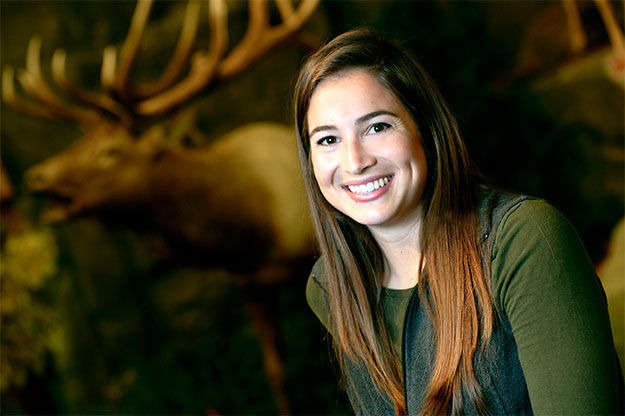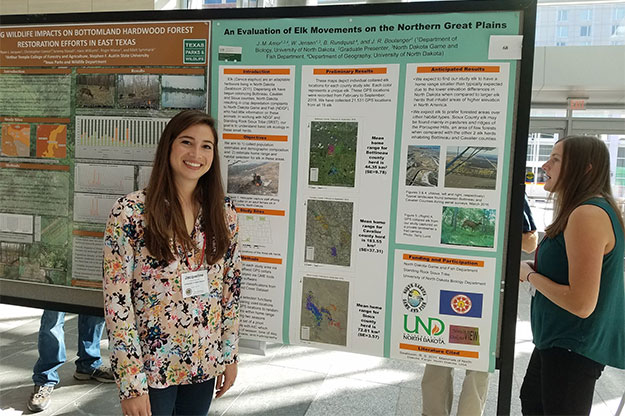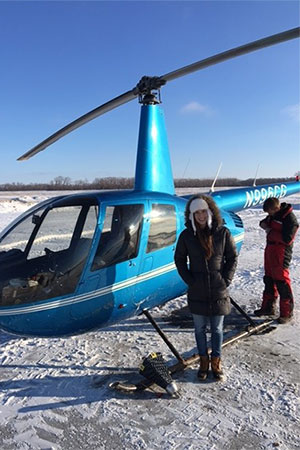Halting the herd mentality
Grad student Jacqueline Amor heads collaborative effort to monitor North Dakota elk and guard against depredation

One of Jacqueline Amor’s fondest memories of growing up in southern Florida is counting alligators during boat rides in the Everglades.
Even when she travelled farther north, she found herself drawn to native fauna.
“Since my mom is from Bemidji, we would come up every summer and we’d go fishing and be outside,” Amor smiled. “To see the different wildlife from Florida to Minnesota was such a delight, and I just fell in love with that stuff.”
Now, instead of counting gators, the UND graduate student is counting big game in North Dakota. Amor is in the driver’s seat of a collaborative effort among the University of North Dakota, the North Dakota Game and Fish Department (NDGF) and the Standing Rock Sioux Tribe to understand the state’s elk population. NDGF big game biologist Bill Jensen says the focus of the study is three small elk herds in Bottineau, Cavalier and Sioux Counties.
“In an effort to get some baseline information on these animals, last February we funded a project to put five GPS collars on elk in each of the three populations,” Jensen said. “North Dakota Game and Fish has had a long history of collaboration with UND. This is just one of many projects we’ve worked on.”

Amor, who is currently pursuing her master’s degree in geography, has an undergraduate degree in wildlife and fisheries biology. Her dual interest had her searching for a thesis topic that would allow a partnership between geography and biology. When her graduate co-adviser, Assistant Professor of Wildlife Ecology and Human Dimensions Jason Boulanger, pitched the project, Amor was all in.
“She really enjoys the remote sensing side of things, but also has the interest in wildlife, so it’s a good fit for her,” Boulanger said. “It’s a good fit for us, too, in the state. So it all kind of came together.”
The study

The elk ecology study became a priority for NDGF when it started to receive complaints of damaged crops in areas where elk are found.
“You’re going to have 50 animals in there that weigh 700 to 1,000 pounds, and that can cause some real issues,” Jensen said. “And in a state where between 90 and 95 percent of the surface area is in private ownership — that can be really problematic.”
Amor’s experiential learning began with flights out west to the herds. She and Boulanger helped set up and test tracking collars that would be passed to a third-party capture crew, which would, in turn, collar the elk. Once the trackers were in place, Amor joined NDGF on aerial surveys to count the elk on the ground and watch their movements.
“Since there’s noise coming from the plane, they’re usually just running, so you won’t see them through the trees,” Armor said, “and then all of a sudden they just come out of nowhere — and they’re hauling! It was just really cool to see them from that point of view.”
Back at UND, Amor is in charge of gathering the location data that comes in every four hours from the GPS collars. She uses that information to estimate the home ranges of the three herds, their habitat resource selection and where they may head next. This information will be used by NDGF and the Standing Rock Sioux Tribe to set harvest rates for hunters and, ultimately, manage the population.
“It’s pretty gratifying to know that what I’m interested in and what I’ve learned is being put to use and can be really helpful for the state,” Amor said. “To know that it goes further than just a master’s degree is satisfying.”
Collaborative benefits
Amor’s work has proved beneficial for the Standing Rock Sioux Tribe, which is in charge of its own wildlife management. Standing Rock Game and Fish Director Jeff Kelly says he’s glad Sioux County was incorporated into the study, because funding for studies like these is hard to find.
“We had a small grant to do a little bit of studying and a little bit of surveying on our own, but this program really helped,” Kelly said. “We’re hoping that the tribe will get to determine the population and roaming area, and what we have to harvest to prevent any depredation.”
Collaboration will continue in the classroom. UND’s Boulanger and NDGF’s Jensen plan to spend time with students at Sitting Bull College to talk about the study and discuss big game management, adding an outreach component to the partnership.
“In the long term, it’s beneficial for us to train young biologists and wildlife management students, and give them career opportunities,” Jensen said. “Because, at some point in time, we’re all going to be retiring, and we’ll need people like Jacqueline and others to take over.”


